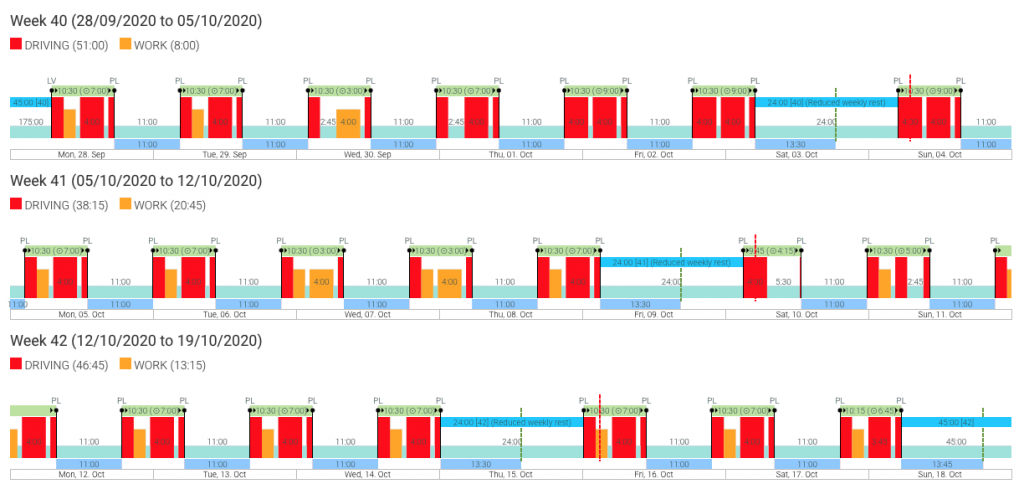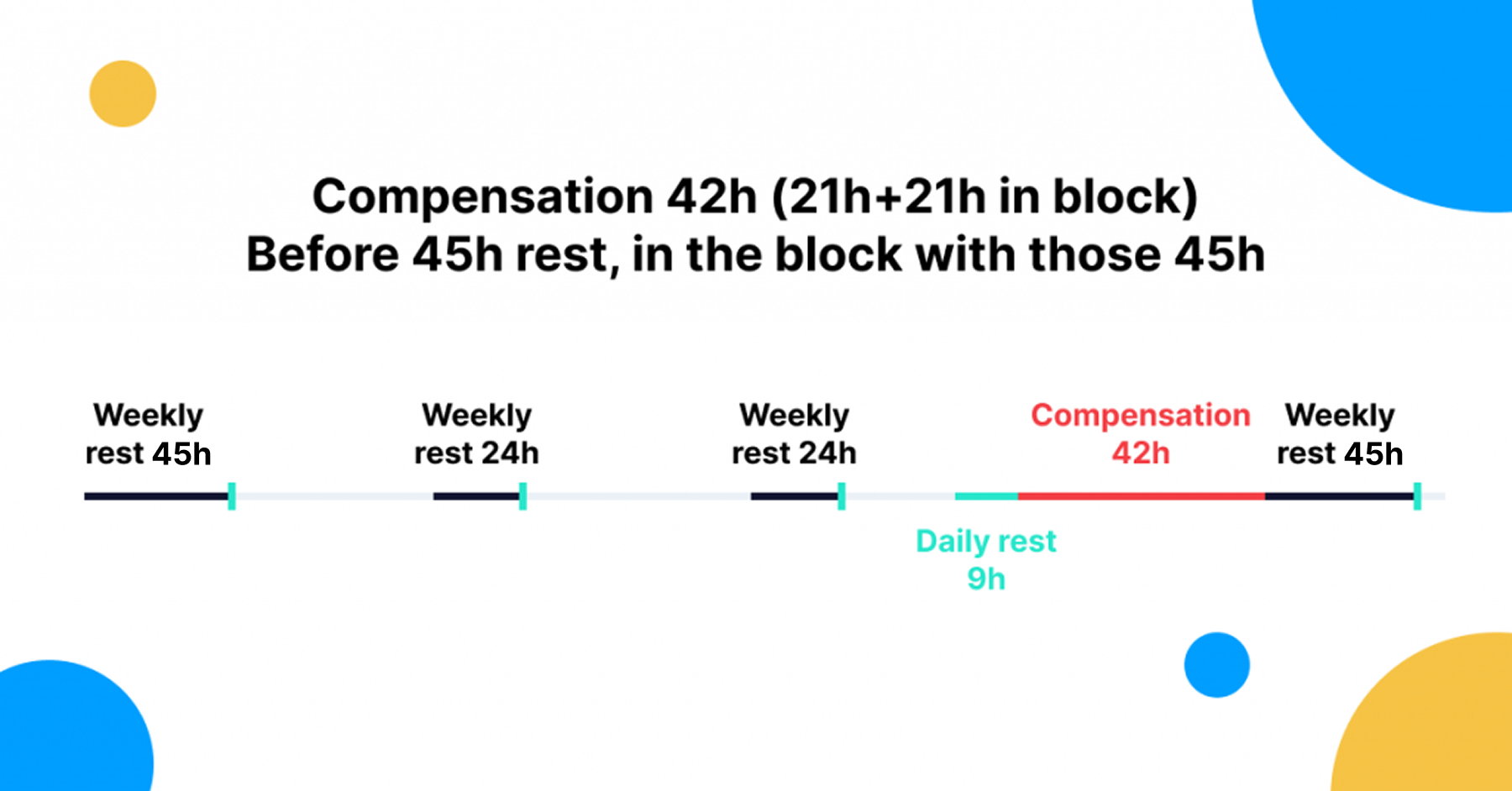
Mobility package regulation: taking two consecutive reduced weekly rests
We're continuing our blog post series on the Mobility Package by covering the most important additions and changes introduced by it. In this blog we will talk about the changes that concern taking two reduced weekly rests in a row. What's interesting about this is that technically you could already take two consecutive reduced weekly rests before the Mobility Package amendments, but there were some tricks involved in doing so. Stay with us to find out what's new.
Reduced and regular weekly rests
Before we get into the changes the Mobility Package has brought to the table, let us first recall, in simple terms, what were the rules before it came into force:
Every two consecutive weeks the driver had to take at least one reduced weekly rest and at least one regular weekly rest;
Every reduced weekly rest had to be compensated till full 45 hours in one go;
The compensation had to be taken before the end of the 3rd week following the week in question;
In case the weekly rest overlapped with the weekend, you could count the rest to one or the other week but not both weeks.
This last point was the one referred to in the introduction and we'd like to expand a little more on it here.
As stated before, it was and is still possible to spend almost three weeks without regular weekly rests and safely return home.
To explain, let's look at the picture below:

Notice the way regular weekly rests overlap on Week 40 and Week 42. Considering this overlap and counting the weekly rests to Week 40 and Week 42 allows us to take even three reduced weekly rests in a row and drive almost three weeks without a 45 hour break.
It should also be noted that it won't be possible to follow this schedule in Week 43, as the regular weekly rest that overlaps with Weeks 42 and 43 will already be added to Week 42. In order to continue using this time planning method, the most optimal solution seems to be for the driver to spend a week at home. This will give a chance to compensate all reduced weekly rest periods, taken together with the regular weekly rest, as well as start the next 45 hour rest period in a way that it overlaps with Week 44, thus starting a new cycle as shown in the picture above.
There are actually quite a few companies using this option for planning their driver work times and we believe it's still a better idea to plan this way rather than use the options introduced by the Mobility Package. More on these options in the next chapter.
Additions brought by the Mobility Package
One of the main reasons behind the work and rest time regulation is without a doubt to improve road safety. However, one of the main points brought to light in discussing the Mobility Package was the need to improve the working conditions of the drivers by making sure they can return home regularly and not spend too much time away from their home countries. Thus, spending a regular weekly rest of at least 45 hours abroad was deemed unnecessary where the driver was capable of safely returning home and taking a proper rest at home with their family.
Therefore, the new regulation introduces the following point:
"(..) a driver engaged in international transport of goods may, outside the Member State of establishment, take two consecutive reduced weekly rest periods provided that the driver in any four consecutive weeks takes at least four weekly rest periods, of which at least two shall be regular weekly rest periods.
For the purpose of this paragraph, a driver shall be considered to be engaged in international transport where the driver starts the two consecutive reduced weekly rest periods outside the Member State of the employer's establishment and the country of the drivers' place of residence."
Put in simple terms, the new rules provide that:
The driver is allowed to work for two consecutive weeks without regular weekly rests (a more explicit definition in our opinion);
This applies only to drivers away from their home countries or away from their employers' establishment countries, as you have to start the reduced weekly rests in a foreign country to qualify for this rule exemption;
The driver still has to take two regular and two reduced weekly rests within a four week period;
Specific reduced weekly rest compensation rules apply (more on this in the following chapter).
It is important to remember that this is not a mandatory rule. It is an additional option introduced in the Mobility Package regulation that comes with its own specific rule set. Therefore, the driver may use this option or he may ignore it and continue to work as before.
It's up to the driver to make this decision.
Compensating two consecutive reduced weekly rests
As everyone already knows, you have to compensate for each and every reduced weekly rest. In case you're taking the two consecutive reduced weekly rests as provided for in the Mobility Package regulation, there are specific rules to keep in mind. In order to compensate them, you have to compensate them en bloc before the next weekly rest.
Let's try to look at it graphically:

In this case, the driver has taken two consecutive reduced weekly rests and in order to be compliant with the compensation rules, he has to take the compensation for these reduced weekly rests before the next weekly rest. Both of the compensations should be done in one go, which means that in this case the regular compensation rules that allow you to do rest compensation till the end of the 3rd week are overridden and for this specific case removes the flexibility that the pre-existing compensation rules provide.
Note that in this case the driver will also have to take a 45 hour rest the following week, as the above-mentioned regulation stipulates that there must be at least four weekly breaks every four consecutive weeks, two of which are regular and two - reduced. As the previous regular weekly rest will no longer be part of the latest four-week period in the following week, a full 45 hour rest will be required here as well.
How do compensations impact daily rest extensions?
In its latest communication about the Mobility Package rules, the EC gives a wider interpretation on how the daily rests can be used as part of the weekly rests.
As stated in the Regulation, a daily rest period may be extended to make a regular weekly rest period or a reduced weekly rest period. That is to say, you don't have to take a 9 hour daily rest and then another 45 hours of weekly rest straight after. Instead, it can just be 45 hours altogether.
And while this has always been the case, with the introduction of the Mobility Package rules it was never really explained on how daily rests interact with weekly rests, when there's a compensation period at play in between. The latest communication from the EC leads to believe that the compensation does not impact this rule. It means that even though the daily rest is technically done before the compensations, which, in turn, have to be taken in full prior to a weekly rest, it can still be counted as part of the weekly rest. See once more the picture above for a visual reference.
We believe that the compensation mechanisms introduced by the Mobility Package regulation are fairly complicated. Although they sound reasonable on paper, in practice we think that it would be better for drivers to use the pre-existing compensation options
- taking regular weekly rests over weekends and roll over the weekly rest to the next week so that the next weekly rest can be taken in three weeks time. Furthermore, considering that the data displayed on a tachograph screen is not compliant with the Mobility Package amendments, using the new rule set may be risky for the drivers.
Either way Tachogram fully supports the Mobility Package rules and handles all the data according to the regulation. If you haven’t already, you can try out Tachogram and find out how it helps to stay compliant with driving and rest time regulation by taking advantage of the 14-day-free trial.